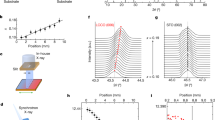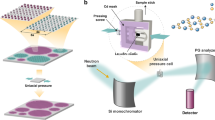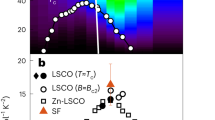Abstract
Although it is generally accepted that superconductivity is unconventional in the high-transition-temperature copper oxides, the relative importance of phenomena such as spin and charge (stripe) order, superconductivity fluctuations, proximity to a Mott insulator, a pseudogap phase and quantum criticality are still a matter of debate1. In electron-doped copper oxides, the absence of an anomalous pseudogap phase in the underdoped region of the phase diagram2 and weaker electron correlations3,4 suggest that Mott physics and other unidentified competing orders are less relevant and that antiferromagnetic spin fluctuations are the dominant feature. Here we report a study of magnetotransport in thin films of the electron-doped copper oxide La2 − xCe x CuO4. We show that a scattering rate that is linearly dependent on temperature—a key feature of the anomalous normal state properties of the copper oxides—is correlated with the electron pairing. We also show that an envelope of such scattering surrounds the superconducting phase, surviving to zero temperature when superconductivity is suppressed by magnetic fields. Comparison with similar behaviour found in organic superconductors5 strongly suggests that the linear dependence on temperature of the resistivity in the electron-doped copper oxides is caused by spin-fluctuation scattering.
This is a preview of subscription content, access via your institution
Access options
Subscribe to this journal
Receive 51 print issues and online access
$199.00 per year
only $3.90 per issue
Buy this article
- Purchase on Springer Link
- Instant access to full article PDF
Prices may be subject to local taxes which are calculated during checkout



Similar content being viewed by others
References
Norman, M. R. The challenge of unconventional superconductivity. Science 332, 196–200 (2011)
Armitage, N. P., Fournier, P. & Greene, R. L. Progress and perspectives on the electron-doped cuprates. Rev. Mod. Phys. 82, 2421–2487 (2010)
Weber, C., Haule, K. & Kotliar, G. Strength of correlations in electron- and hole-doped cuprates. Nature Phys. 6, 574–578 (2010)
Senechal, D. & Tremblay, A.-M. S. Hot spots and pseudogaps for hole- and electron-doped high-temperature superconductors. Phys. Rev. Lett. 92, 126401 (2004)
Doiron-Leyraud, N. et al. Correlation between linear resistivity and T c in the Bechgaard salts and the pnictide superconductor Ba(Fe1−x Co x )2As2 . Phys. Rev. B 80, 214531 (2009)
Löhneysen, H., v, Rosch, A., Vojta, M. & Wölfle, P. Fermi-liquid instabilities at magnetic quantum phase transitions. Rev. Mod. Phys. 79, 1015–1075 (2007)
Moriya, T. & Ueda, K. Spin fluctuations and high temperature superconductivity. Adv. Phys. 49, 555–606 (2000)
Sachdev, S. & Keimer, B. Quantum criticality. Phys. Today 64, 29–35 (2011)
Rosch, A. Magnetotransport in nearly antiferromagnetic metals. Phys. Rev. B 62, 4945–4962 (2000)
Bourbonnais, C. & Sedeki, A. Link between antiferromagnetism and superconductivity probed by nuclear spin relaxation in organic conductors. Phys. Rev. B 80, 085105 (2009)
Taillefer, L. Scattering and pairing in cuprate superconductors. Annu. Rev. Cond. Matter Phys. 1, 51–70 (2010)
Fournier, P. et al. Insulator-metal crossover near optimal doping in Pr2-x Ce x CuO4: Anomalous normal-state low temperature resistivity. Phys. Rev. Lett. 81, 4720–4723 (1998)
Dagan, Y. et al. Evidence for a quantum phase transition in Pr2-x Ce x CuO4-δ . Phys. Rev. Lett. 92, 167001 (2004)
Matsui, H. et al. Evolution of the pseudogap across the magnet-superconductor phase boundary of Nd2-x Ce x CuO4 . Phys. Rev. B 75, 224514 (2007)
Helm, T. et al. Evolution of the Fermi surface of the electron-doped high-temperature superconductor Nd2-x Ce x CuO4 revealed by Shubnikov–de Haas oscillations. Phys. Rev. Lett. 103, 157002 (2009)
Sawa, A. et al. Electron-doped superconductor La2-x Ce x CuO4: preparation of thin films and modified doping range for superconductivity. Phys. Rev. B 66, 014531 (2002)
Jin, K. et al. Normal-state transport in electron-doped La2-x Ce x CuO4 thin films in magnetic fields up to 40 Tesla. Phys. Rev. B 77, 172503 (2008)
Jin, K. et al. Evidence for antiferromagnetic order in La2-x Ce x CuO4 from angular magnetoresistance measurements. Phys. Rev. B 80, 012501 (2009)
Jin, K. et al. Low-temperature Hall effect in electron-doped superconducting La2-x CexCuO4 thin films. Phys. Rev. B 78, 174521 (2008)
Cooper, R. A. et al. Anomalous criticality in the electrical resistivity of La2-x Sr x CuO4 . Science 323, 603–607 (2009)
Daou, R. et al. Linear temperature dependence of resistivity and change in the Fermi surface at the pseudogap critical point of a high-T c superconductor. Nature Phys. 5, 31–34 (2009)
Motoyama, E. M. et al. Spin correlations in the electron-doped high-transition-temperature superconductor Nd2 − x Ce x CuO4 ± δ . Nature 445, 186–189 (2007)
Lin, J. & Millis, A. J. Theory of low-temperature Hall effect in electron-doped cuprates. Phys. Rev. B 72, 214506 (2005)
Fujita, M. et al. Low-energy spin fluctuations in the ground states of electron-doped Pr1-x LaCe x CuO4+δ cuprate superconductors. Phys. Rev. Lett. 101, 107003 (2008)
Nakamae, S. et al. Electronic ground state of heavily overdoped nonsuperconducting La2-x Sr x CuO4 . Phys. Rev. B 68, 100502 (2003)
Kubo, Y., Shimakawa, Y., Manako, T. & Igarashi, H. Transport and magnetic properties of Tl2Ba2CuO6+δ showing a δ-dependent gradual transition from an 85-K superconductor to a nonsuperconducting metal. Phys. Rev. B 43, 7875–7882 (1991)
Scalapino, D. J. The case for d x2 −y2 pairing in the cuprate superconductors. Phys. Rep. 250, 329–365 (1995)
Dhokarh, D. D. & Chubukov, A. V. Self-consistent Eliashberg theory, Tc, and the gap function in electron-doped cuprates. Phys. Rev. B 83, 064518 (2011)
Monthoux, P., Pines, D. & Lonzarich, G. G. Superconductivity without phonons. Nature 450, 1177–1183 (2007)
Acknowledgements
We thank L. Taillefer for extensive discussions and N. Doiron-Leyraud for some preliminary analysis of our zero-field data. We also appreciate discussions with A. Chubukov, A. Millis and C. Varma. Some experimental help was provided by X. Zhang, P. Bach and G. Droulers. This research was supported by the NSF under DMR-0952716 (J.P. and K.K.) and DMR-0653535 (R.L.G.) and the Maryland Center for Nanophysics and Advanced Materials (K.J. and N.P.B.).
Author information
Authors and Affiliations
Contributions
K.J. prepared and characterized the thin-film samples. K.J., N.P.B., K.K. and J.P. performed the transport measurements and data analysis. N.P.B., J.P. and R.L.G. wrote the manuscript. R.L.G. conceived and directed the project.
Corresponding author
Ethics declarations
Competing interests
The authors declare no competing financial interests.
Supplementary information
Supplementary Information
This file contains Supplementary Text and Supplementary Figures 1-6 with legends. (PDF 817 kb)
Rights and permissions
About this article
Cite this article
Jin, K., Butch, N., Kirshenbaum, K. et al. Link between spin fluctuations and electron pairing in copper oxide superconductors. Nature 476, 73–75 (2011). https://doi.org/10.1038/nature10308
Received:
Accepted:
Published:
Issue Date:
DOI: https://doi.org/10.1038/nature10308
This article is cited by
-
The breakdown of both strange metal and superconducting states at a pressure-induced quantum critical point in iron-pnictide superconductors
Nature Communications (2023)
-
A quantitative description of high-temperature superconductivity
Nature Physics (2023)
-
Interplay between superconductivity and the strange-metal state in FeSe
Nature Physics (2023)
-
Planckian dissipation and non-Ginzburg-Landau type upper critical field in Bi2201
Science China Physics, Mechanics & Astronomy (2023)
-
Signatures of a strange metal in a bosonic system
Nature (2022)
Comments
By submitting a comment you agree to abide by our Terms and Community Guidelines. If you find something abusive or that does not comply with our terms or guidelines please flag it as inappropriate.



